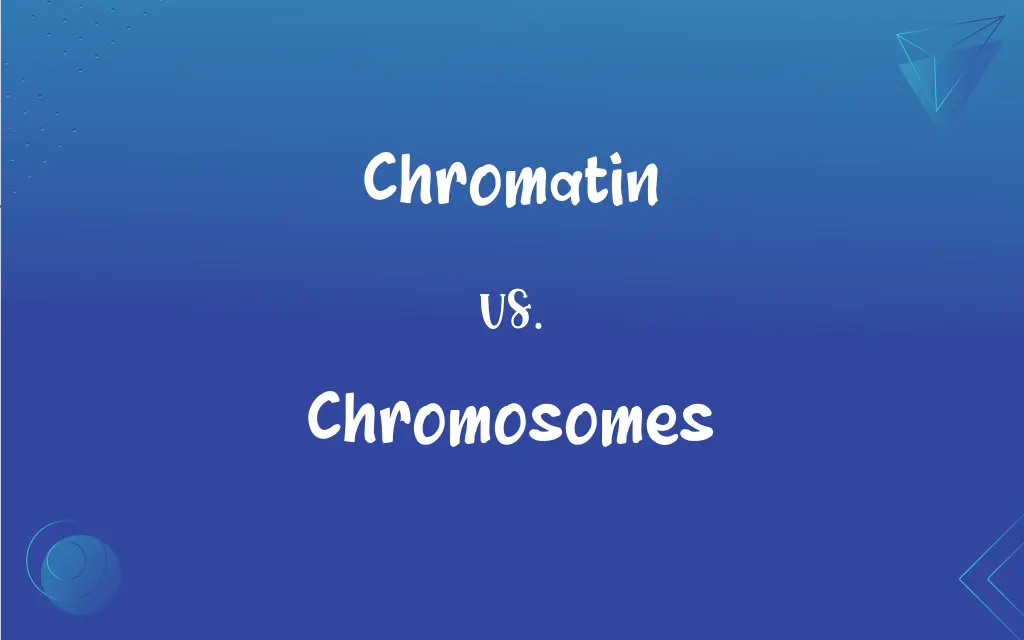Chromatin vs. Chromosomes: What's the Difference?
Edited by Janet White || By Harlon Moss || Updated on October 28, 2023
Chromatin is DNA entwined around proteins; chromosomes are condensed chromatin during cell division.

Key Differences
Chromatin, a complex of DNA and proteins, exists within the nucleus of cells, providing a relaxed, unpackaged form of genetic material. Chromosomes, on the other hand, are tightly packed structures of chromatin, visible during cell division.
While chromatin allows for easier access to DNA for transcription and replication, chromosomes ensure organized and equal distribution of genetic material during cell division. The structure of chromatin is loose and fibrous, whereas chromosomes appear as distinct, X-shaped structures.
Chromatin is present throughout the cell cycle, playing a role in gene expression and DNA repair. Chromosomes only become distinct entities during the metaphase of cell division, critical for the accurate segregation of genetic material.
The composition of chromatin includes DNA wound around histone proteins, forming a bead-on-a-string structure. In contrast, chromosomes consist of chromatin that has been supercoiled and condensed to facilitate movement during mitosis or meiosis.
In terms of function, chromatin regulates gene activity and DNA accessibility. Chromosomes, however, are primarily involved in ensuring the precise division of genetic information between daughter cells.
ADVERTISEMENT
Comparison Chart
Structure
Loose, fibrous.
Condensed, distinct shapes.
Presence
Throughout the cell cycle.
Visible during cell division.
Function
Allows DNA transcription, gene regulation.
Ensures equal DNA distribution during division.
Composition
DNA wrapped around histone proteins.
Supercoiled chromatin.
Role in Gene Expression
Regulates gene activity.
Not directly involved in gene expression.
ADVERTISEMENT
Chromatin and Chromosomes Definitions
Chromatin
Contains histone proteins.
Histones played a crucial role in chromatin structure.
Chromosomes
Condensed genetic material.
During mitosis, the chromosomes became visible.
Chromatin
Loose form of genetic material.
Transcription factors accessed genes in the chromatin.
Chromosomes
Structures during cell division.
Chromosomes lined up at the metaphase plate.
Chromatin
Fibrous material in the nucleus.
Genetic information was stored in the chromatin.
Chromosomes
Ensure DNA segregation.
Chromosomes divided to ensure genetic continuity.
Chromatin
Complex of DNA and proteins.
The cell's chromatin was undergoing replication.
Chromosomes
Carriers of genes.
Each chromosome contained numerous genes.
Chromatin
Present throughout cell cycle.
Chromatin remained in the nucleus during interphase.
Chromosomes
Become visible in metaphase.
The cell's chromosomes condensed in preparation for division.
Chromatin
A complex of nucleic acids and proteins, primarily histones, in the cell nucleus that stains readily with basic dyes and condenses to form chromosomes during cell division.
Chromosomes
A linear strand of DNA and associated proteins in the nucleus of eukaryotic cells that carries the genes and functions in the transmission of hereditary information.
Chromosomes
A circular strand of DNA in bacteria and archaea that contains the hereditary information necessary for cell life.
Chromosomes
Plural of chromosome
FAQs
How many chromosomes do humans have?
Humans have 46 chromosomes.
Does chromatin participate in gene regulation?
Yes, it plays a key role in gene regulation.
What is chromatin made of?
DNA entwined around histone proteins.
Can chromatin structure affect gene expression?
Yes, its structure can regulate gene accessibility.
Do chromosomes have a specific shape?
Yes, typically X-shaped during division.
Can environmental factors affect chromatin?
Yes, they can influence chromatin structure.
Can chromosomes be artificially altered?
Yes, through genetic engineering techniques.
When do chromosomes become visible?
During the metaphase of cell division.
Is chromatin present in non-dividing cells?
Yes, it's present throughout the cell cycle.
Do chromosomes change during a cell's life cycle?
Yes, they condense and decondense.
How many chromosomes are in a gamete?
Half the number of somatic cells.
Are chromosomes duplicated during cell division?
Yes, they're duplicated prior to division.
Can chromatin structure be altered?
Yes, it changes based on cellular needs.
Are chromosomes unique to each individual?
Yes, except for identical twins.
Are chromosomes always condensed?
No, only during cell division.
Is chromatin visible under a microscope?
Not as distinctly as chromosomes.
Does chromatin contain all genetic information?
Yes, it encompasses all genetic material.
Do chromosomes contain genes?
Yes, they are carriers of genes.
Does chromatin play a role in DNA repair?
Yes, it's involved in DNA repair mechanisms.
Is chromatin involved in DNA replication?
Yes, it's essential for DNA replication.
About Author
Written by
Harlon MossHarlon is a seasoned quality moderator and accomplished content writer for Difference Wiki. An alumnus of the prestigious University of California, he earned his degree in Computer Science. Leveraging his academic background, Harlon brings a meticulous and informed perspective to his work, ensuring content accuracy and excellence.
Edited by
Janet WhiteJanet White has been an esteemed writer and blogger for Difference Wiki. Holding a Master's degree in Science and Medical Journalism from the prestigious Boston University, she has consistently demonstrated her expertise and passion for her field. When she's not immersed in her work, Janet relishes her time exercising, delving into a good book, and cherishing moments with friends and family.
































































